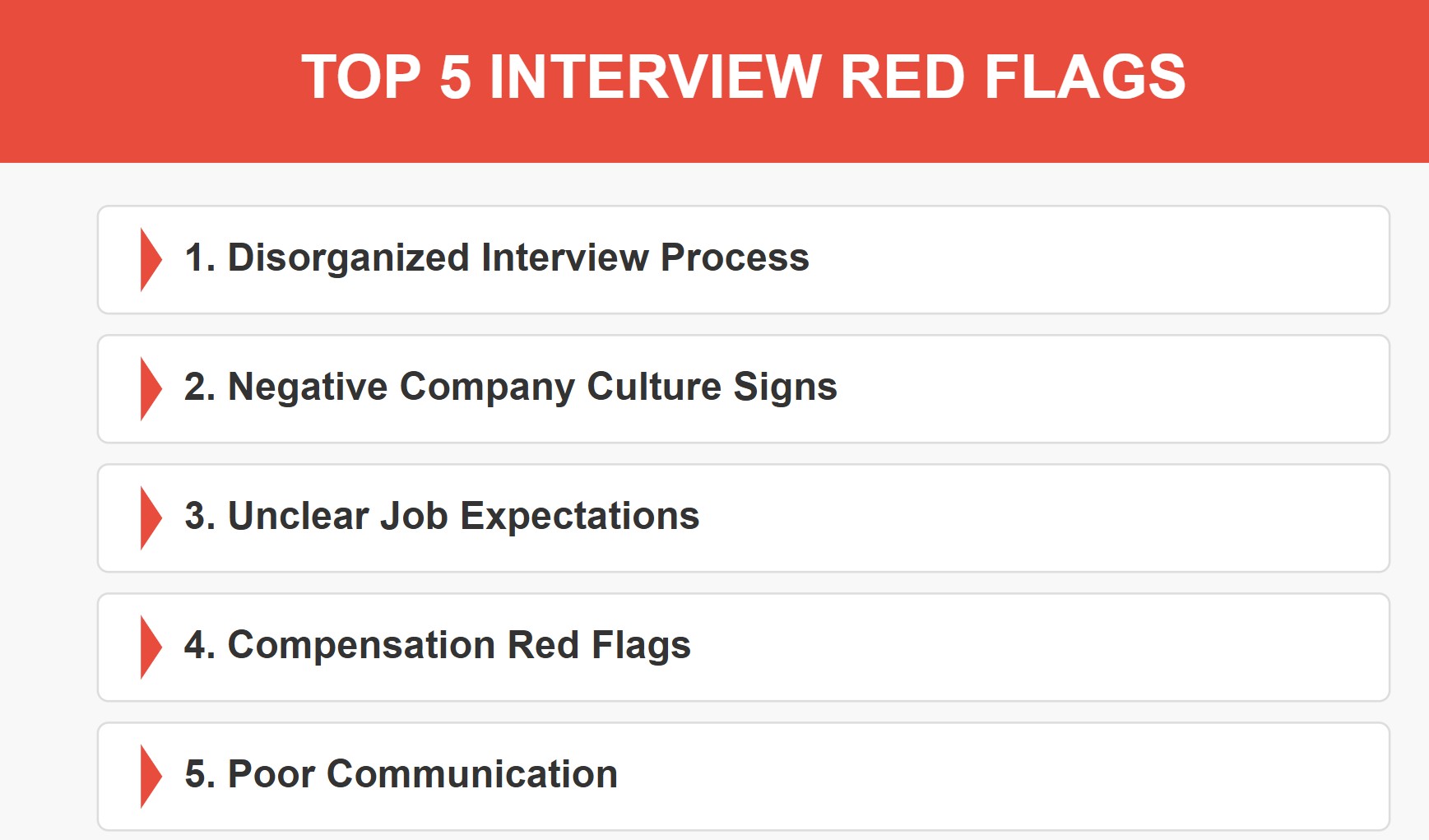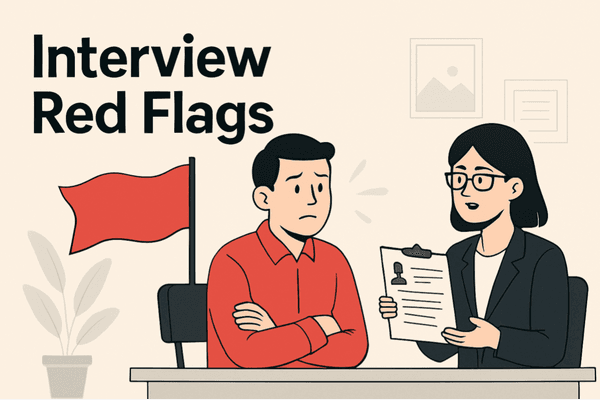Hiring is a two-way street—and interviews are the crossroads where both candidates and employers reveal their true colors. But how do you know if something’s off? Whether you're a job seeker concerned about wasting time or a hiring manager trying to spot potential risks, recognizing interview red flags is critical for making informed decisions.
What Is the Biggest Red Flag in an Interview?
The most significant red flag in any interview scenario is lack of preparation.
For candidates, this might look like not knowing the company’s products, mission, or even the role itself. For interviewers, it often shows up as being unprepared with questions, forgetting the candidate’s background, or having no clear interview structure.
This indicates disinterest, disorganization, or misalignment—none of which support a positive outcome.

Common Interview Red Flags
For Employers Evaluating Candidates:
- Vague or generic answers to questions about past experience
- Speaking negatively about former employers, managers, or colleagues
- A pattern of short stints at multiple companies without explanation
- Lack of curiosity about the role or organization
- Overconfidence that isn’t backed by clear evidence or examples
For Candidates Evaluating Employers:
- Disorganized interview process, such as last-minute reschedules or interviewer no-shows
- Inconsistent messaging from different interviewers about the role or company vision
- Red flags about toxic culture (e.g., bragging about long hours or high turnover)
- No mention of professional development or career growth
- Evasive or vague responses to questions about leadership, expectations, or success metrics
What Are the 5 C’s of Interviewing?
The 5 C's offer a framework to evaluate interview quality and alignment:
- Clarity – Are the goals, expectations, and responsibilities clearly communicated?
- Consistency – Are all candidates being evaluated using the same criteria and process?
- Culture – Does the candidate or employer align with the values and environment?
- Communication – Is there professionalism, respect, and responsiveness?
- Credibility – Are claims verifiable and answers reliable?
Is 5 Interviews a Red Flag?
Not necessarily. For some roles—especially senior or cross-functional positions—multiple rounds are appropriate. However, it becomes a red flag when:
- There's no clear purpose for each round
- Feedback is inconsistent or lacking
- The process feels drawn out without transparency
- Candidates feel like they’re being assessed over and over without new information
Lengthy interview processes can signal indecisiveness, poor coordination, or internal dysfunction.
What Are CV Red Flags?
Hiring managers often scan for the following resume concerns:
- Unexplained gaps in employment history
- Frequent job changes with no clear reason or progression
- Typos, grammatical errors, or inconsistent formatting
- Inflated job titles or unverifiable achievements
- Irrelevant experience not tailored to the role or industry
What Interviewers Say That Suggests You Won’t Get the Offer
Sometimes the writing is on the wall. Common phrases that may signal rejection include:
- “We’re still seeing a few more candidates.”
- “You’re a great fit for other roles in the future.”
- “We’ll keep your resume on file.”
- “You’re overqualified.”
- “It was great getting to know you.”
While not definitive, these phrases are often used to soften the message of non-selection.
What Color Stands Out in an Interview?
When it comes to attire, navy blue is widely regarded as professional and trustworthy. Other safe choices include charcoal gray or black. Bright colors or flashy patterns can be distracting unless you're interviewing in a highly creative field where personal expression is encouraged.
What Is the Golden Rule in Interviewing?
Treat others how you would want to be treated.
This applies equally to both candidates and hiring teams. Respect for time, preparation, honest communication, and transparency are all foundational to a productive and positive interview process.
What Is the STAR Method?
The STAR method is a proven technique for answering behavioral interview questions:
- Situation – Set the scene with background context.
- Task – Describe the specific challenge or responsibility.
- Action – Explain what actions you took to address it.
- Result – Share the outcome, ideally with measurable impact.
It helps candidates deliver focused, structured, and relevant answers—and helps interviewers evaluate responses objectively.

What Are the 4 Pillars of Interviewing?
These pillars ensure a consistent and high-quality process:
- Preparation – Define clear roles, questions, and criteria.
- Structure – Use a repeatable format to reduce bias.
- Evaluation – Apply consistent scoring or notes.
- Feedback – Provide timely updates to all candidates.
Do Employers Interview the Best Candidate First?
Interview scheduling is often based on availability, not preference. However, some organizations try to interview top candidates early to prevent losing them to competitors. Regardless of order, every interview should be treated as if it’s the final decision-maker.
What Is a Red Flag for HR?
From an HR perspective, the most concerning red flags include:
- Discrepancies between resume and verbal responses
- Evasive answers about employment history or responsibilities
- Aggressive or disrespectful behavior
- Unwillingness to provide references or verify credentials
- Overemphasis on salary without interest in role responsibilities
What Is Interview Fatigue?
Interview fatigue happens when candidates—or even hiring managers—go through too many interview rounds, leading to:
- Decreased energy and enthusiasm
- Repetitive or unfocused conversations
- Difficulty recalling earlier candidates
- Weakened decision-making
Over-interviewing can compromise the experience and reduce the likelihood of successful outcomes.
What Are the 5 D Red Flags?
This term refers to behavioral signs that raise serious concern:
- Dishonesty – Inconsistent or exaggerated information
- Defensiveness – Resistance to feedback or probing questions
- Disrespect – Toward team members, previous employers, or interviewers
- Disinterest – Lack of curiosity or engagement
- Divergence – A significant mismatch between the candidate and job requirements
What Makes a CV Get Rejected?
A CV might be rejected for reasons such as:
- Poor formatting that’s hard to scan
- Overuse of buzzwords without substance
- Generic content not aligned to the job posting
- No quantifiable achievements
- Lack of career progression or focus
What Colour Stands Out on a CV?
Subtle accents in blue, dark green, or gray can help your resume stand out while maintaining professionalism. Avoid overly bright or neon colors, which can appear unpolished or distract from content.
How Do I Know If an Interview Went Badly?
Common signs of a negative interview outcome include:
- Interview ending much earlier than expected
- Little or no discussion of next steps
- The interviewer seemed distracted, disinterested, or rushed
- You weren’t asked follow-up or behavioral questions
- You didn’t have a chance to ask questions
While not always conclusive, these are worth noting for future reference.
Can an Interview Go Well But Still No Offer?
Yes. A candidate may perform well but still not receive an offer due to:
- A stronger candidate being selected
- Budget changes or hiring freezes
- Internal candidates filling the role
- Misalignment on salary expectations or team dynamics
It’s possible to do everything right and still not be chosen—it’s part of the hiring process.
When Should I Assume I Didn’t Get the Job?
If more than 10 business days have passed since your last interview and you’ve received no update—even after a polite follow-up—it’s reasonable to assume you weren’t selected.
Also consider these signs:
- The job has been reposted
- Your follow-up emails have gone unanswered
- You were told a decision would be made by a certain date, and it has passed
Final Thoughts
Interviewing is about alignment—skills, expectations, culture, and communication. Spotting red flags early allows both candidates and employers to make better decisions and avoid poor fits. If something feels off, it’s worth paying attention. Ultimately, a strong interview process should be transparent, respectful, and mutually beneficial.
Frequently Asked Questions
What’s the biggest interview red flag?
The biggest red flag is lack of preparation. Whether it's the interviewer or the candidate, showing up unprepared demonstrates a lack of respect for the other person's time and a lack of seriousness about the opportunity.
Are too many interview rounds a bad sign?
Excessive interview rounds, especially without clear purpose or structure, often point to disorganization, internal misalignment, or decision paralysis. While some senior roles justify extended processes, transparency is key. Candidates should be informed of the steps upfront.
What makes a CV stand out for the right reasons?
A strong CV includes:
- Clear structure and clean formatting
- Results-oriented bullet points
- Tailored content for the specific job
- Measurable achievements (e.g., "Increased sales by 20%")
- Professional language free of jargon or filler
Can I still get a job after a bad interview?
Occasionally, yes—especially if the hiring team saw potential and there’s room for clarification. Following up with a thoughtful thank-you note or additional materials can help. But in most cases, performance during the interview is a key deciding factor.
What’s the most underrated sign of a good employer?
A respectful and transparent interview process. When employers communicate clearly, respect candidates’ time, and offer feedback—even when declining—that’s a strong sign of a healthy workplace culture.
Looking to optimize your hiring process or job search experience? Reach out for expert frameworks, checklists, and HR tools tailored to your goals.
